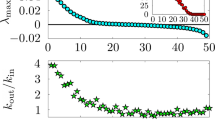Abstract
The practical significance of bio-inspired, self-organising methods is rapidly increasing due to their robustness, adaptability and capability of handling complex tasks in a dynamically changing environment. Our aim is to examine an artificial hormone system that was introduced in order to deliver multimedia content in dynamic networks. The artificial hormone algorithm proved to be an efficient approach to solve the problem during the experimental evaluations. In this paper we focus on the theoretical foundation of its goodness. We show that the hormone levels converge to a limit at each node in the typical cases. We form a series of theorems on convergence with different conditions which are built on each other by starting with a specific base case and then we consider more general, practically relevant cases. The theorems are proved by exploiting the analogy between the Markov chains and the artificial hormone system. We examine spatial and temporal monotonicity of the hormone levels as well and give sufficient conditions on monotonic increase.
Similar content being viewed by others
References
Amorim P (2014) Modeling ant foraging: a chemotaxis approach with pheromones and trail formation. Technical report, Universidade Federal do Rio de Janeiro. Submitted, avalaible at the http://arxiv.org/abs/1409.3808
Babaoglu O, Canright G, Deutsch A, Caro GD, Ducatelle F, Gambardella LM, Ganguly N, Jelasity M, Montemanni R, Montresor A, Urnes T (2006) Design patterns from biology for distributed computing. ACM Trans Auton Adapt Syst 1:26–66
Badr A, Fahmy A (2004) A proof of convergence for Ant algorithms. Inf Sci 3(1):2232
Benezit F, Denantes P, Dimakis AG, Thiran P, Vetterli M (2008) Reaching consensus about gossip: convergence times and costs. Information Theory and Applications Workshop, January 2008
Blondel VD, Hendrickx JM, Olshevsky A, Tsitsiklis JN (2005) Convergence in multiagent coordination, consensus, and flocking. Proceedings of the 44th IEEE Conference on Decision and Control, and the European Control Conference, CDC-ECC ’05, 2996–3000
Brinkschulte U, Pacher M, von Renteln A (2007) Towards an artificial hormone system for self-organizing real-time task allocation. In: Proceedings of the 5th IFIP Workshop on Software Technologies for Future Embedded & Ubiquitous Systems, pp 339–347
Calvet LE, Fisher AJ (2001) Forecasting multifractal volatility. J Econom 105(1):2758
Canright G, Deutsch A, Urnes T (2006) Chemotaxis-inspired load balancing. ComPlexUs 3(1–3):8–23
Cybenko G (1989) Dynamic load balancing for distributed memory multiprocessors. J Parallel Distrib Comput 7(2):279–301
Elmenreich W, D’Souza R, Bettstetter C, de Meer H (2009) A survey of models and design methods for self-organizing networked systems. Proceedings of the Fourth International Workshop on Self-Organizing Systems, vol 5918., Lecture Notes in Computer Science. Springer, Berlin/Heidelberg, pp 37–49
Grinstead CH, Snell JL (1997) Introduction to probability. AMS, Providence
Gutjahr WJ (2002) ACO algorithms with guaranteed convergence to the optimal solution. Inf Process Lett 82(3):145–153
Hillen T, Painter KJ (2009) A users guide to PDE models for chemotaxis. J Math Biol 58(1–2):183–217
Horstmann D (2003) From 1970 until present: the Keller-Segel model in chemotaxis and its consequences. I Jahresber Deutsch Math-Verein 105(3):103–165
Kharbouch AA, Said MR, Oppenheim AV (2007) A bacterial algorithm for surface mapping using a Markov modulated Markov chain model of bacterial chemotaxis. 2007 IEEE International Conference on Acoustics, Speech and Signal Processing - ICASSP 07, vol 3, pp 781–784, 15–20 April 2007
Klinglmayr J, Bettstetter C (2012) Self-organizing synchronization with inhibitory-coupled oscillators: convergence and robustness. ACM Transactions on Autonomous and Adaptive Systems, 7(3), Article 30 (October 2012), 23 p
Leidenfrost R, Elmenreich W, Bettstetter C (2010) Fault-tolerant averaging for self-organizing synchronization in wireless Ad hoc networks. Proceedings of the International Symposium on Wireless Communication Systems (ISWCS). York, UK, pp 721–725
Said MR, Oppenheim AV, Lauffenburger DA (2003) Modeling cellular signal processing using interacting markov chains. In: Proceedings of International Conference on Acoustics, Speech, Signal Processing (ICASSP)
Schelfthout K, Holvoet T (2005) A Pheromone-based coordination mechanism applied in peer-to-peer. Agents and Peer-to-Peer Computing, vol 2872., Lecture Notes in Computer Science. Springer, Berlin/Heidelberg, pp 109–132
Sobe A (2011) Self-organizing multimedia delivery—towards emerging delivery paradigms for non-sequential media access, PhD Thesis. Alpen-Adria Universität Klagenfurt, pp 71–79
Sobe A, Böszörmenyi L, Taschwer M (2010) Video notation (ViNo): a formalism for describing and evaluating non-sequential multimedia access. IARIA Int J Adv Softw 3(12):19–30
Sobe A, Elmenreich W, Szkaliczki T, Böszörmenyi L (2015) SEAHORSE: generalizing an artificial hormone system algorithm to a middleware for search and delivery of information units. Elsevier Comput Netw 80:124–142
Sobe A, Elmenreich W (2013) Replication and replacement in dynamic delivery networks. Complex Adaptive Systems Modeling, Special Issue on Multidisciplinary applications of Complex Networks Modeling, Simulation, Visualization & Analysis. Springer Open Access, vol 1:13
Sobe A, Elmenreich W, Böszörmenyi L (2010) Towards a self-organizing replication model for non-sequential media access. Proceedings of the 2010 ACM workshop on Social, adaptive and personalized multimedia interaction and access (SAPMIA 2010), Florence, Italy, pp 3–8
Sobe A, Elmenreich W, Böszörmenyi L (2015) Replication for bio-inspired delivery in unstructured Peer-to-Peer networks. In: Ninth Workshop on Intellingent Solutions for Embedded Systems (WISES), IEEE, pp 109–116
Sobe A, Elmenreich W. Videonetwork. http://code.google.com/p/videonetwork/, 2009–2012
Stützle T, Dorigo M (2002) A short convergence proof for a class of Ant colony optimization algorithms. IEEE Trans Evol Comput 6(4):358–365
Szkaliczki T, Sobe A, Böszörmenyi L (2012) Discovering bounds of performance of self-organizing content delivery systems. Proceedings of 1st International Workshop on Evaluation of Self-Adaptive and Self-Organizing Systems - Tools, Techniques and Case studies, Lyon, France, pp 97–104
Acknowledgments
Research is supported by the Hungarian National Development Agency under Grant HUMAN_MB08-1-2011-0010. Special thanks are due to Katalin Friedl and László Böszörmenyi for the consultations on the hormone algorithms and the convergence.
Author information
Authors and Affiliations
Corresponding author
Rights and permissions
About this article
Cite this article
Szkaliczki, T., Sobe, A. & Elmenreich, W. Convergence and monotonicity of the hormone levels in a hormone-based content delivery system. Cent Eur J Oper Res 24, 939–964 (2016). https://doi.org/10.1007/s10100-015-0412-9
Published:
Issue Date:
DOI: https://doi.org/10.1007/s10100-015-0412-9




